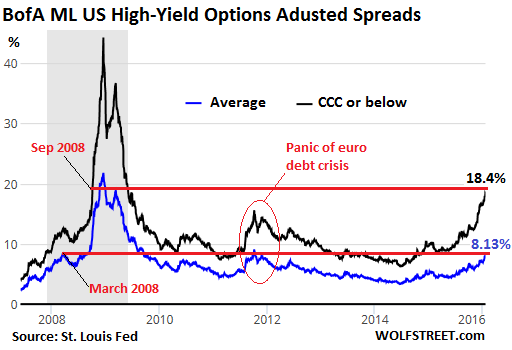This is Why Junk Bonds Will Sink Stocks: Moody’s
“Some very critical things are hidden.”
After the white-knuckle sell-off of global equities that was finally punctuated by a rally late last week, everyone wants to know: Was this the bottom for stocks? And now Moody’s weighs in with an unwelcome warning.
If you want to know where equities are going, look at junk bonds, it says. Specifically, look at the spread in yield between junk bonds and Treasuries. That spread has been widening sharply. And look at the Expected Default Frequency (EDF), a measure of the probability that a company will default over the next 12 months. It has been soaring.
They do that when big problems are festering: The Financial Crisis was already in full swing before the yield spread and the EDF reached today’s levels!
And so, John Lonski, chief economist at Moody’s Capital Markets Research, has a dose of reality for stock-market bottom fishers:
For now, it’s hard to imagine why the equity market will steady if the US high-yield bond spread remains wider than 800 basis points [8 percentage points]. Taken together, the highest average EDF metric of US/Canadian non-investment-grade companies of the current recovery and its steepest three-month upturn since March 2009 favor an onerous high-yield bond spread of roughly 850 basis points.
Moody’s EDF began spiking last summer and has nearly doubled since then to 8%, the highest since 2009.
The average spread between high-yield bonds and Treasuries has widened to 813 basis points (8.13 percentage points). But at the lower end of the junk-bond spectrum (rated CCC and below), the yield spread is a red-hot 18.4 percentage points.
This chart shows the average high-yield spread (blue line) and the CCC-and-below spread (black line). Note how far we were already into the Financial Crisis before both spreads reached the today’s levels: March 13, 2008, and September 30, 2008, respectively:

So how does the yield spread impact equities and the broader economy?
…click on the above link to read the rest of the article…